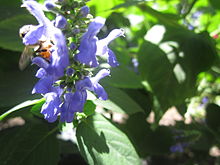Salvia polystachia, also spelt Salvia polystachya, is a herbaceous perennial native to central Mexico and south through Central America into Panama,[1] typically growing at elevations from 5,000 to 10,000 feet in mild climates where there is some summer rain. It is one of the species used as chia[3] and it is rarely seen in horticulture.[4]
| Salvia polystachia | |
|---|---|

| |
| Scientific classification | |
| Kingdom: | Plantae |
| Clade: | Tracheophytes |
| Clade: | Angiosperms |
| Clade: | Eudicots |
| Clade: | Asterids |
| Order: | Lamiales |
| Family: | Lamiaceae |
| Genus: | Salvia |
| Species: | S. polystachia
|
| Binomial name | |
| Salvia polystachia | |
| Synonyms[1] | |
|
List
| |
Description
editSalvia polystachia grows up to 3–9 ft (1–3 m) in one season, preferring the shelter of other plants because the stems become very brittle. It blooms in late summer or early fall, with 0.5 in (13 mm) flowers that are violet-blue at the edge and fading to white at the center. Many short and slender spikes with verticils of tightly held flowers give the plant its specific epithet polystachia. The leaves are yellow-green, 1 in (2.5 cm) long and wide, and grow in small clusters.[4]
Taxonomy
editThe species was first described by Antonio José Cavanilles in 1791 using the spelling Salvia polystachia.[5] As of May 2024[update], this was the spelling used by Plants of the World Online, the International Plant Names Index, and Tropicos.[1][6][7] In 1798, Casimiro Gómez Ortega published a description of the species which explicitly referred to Cavanilles' name, but spelt the epithet polystachya.[8] Tropicos regards this as an illegitimate homonym ("nom. illeg. hom.") of Cavanilles' name.[2] Other sources use Ortega's spelling for the epithet; for example, "Salvia polystachya Ort." was used by Calzada et al. in 2010.[3]
To add to the potential confusion, in 1844, Martin Martens and Henri Guillaume Galeotti published the name Salvia polystachya for a different species. As of May 2024[update], Plants of the World Online regarded this as an illegitimate synonym of Salvia xalapensis.[9]
Phytochemistry
editFrom the aerial parts of Salvia polystachia five neo-clerodane diterpenoids, polystachynes A-E, have been isolated. The structures were established by spectroscopic methods. Other clerodanes such as salvifaricin, linearolactone and dehydrokerlin were also isolated.[10]
References
edit- ^ a b c d "Salvia polystachia Cav." Plants of the World Online. Royal Botanic Gardens, Kew. Retrieved 2024-05-02.
- ^ a b "Salvia polystachya Ortega". Tropicos. Missouri Botanical Garden. Retrieved 2024-05-02.
- ^ a b Calzada, Fernando; Yepez-Mulia, Lilian; Tapia-Contreras, Amparo; Bautista, Elihú; Maldonado, Emma; Ortega, Alfredo (May 2010). "Evaluation of the antiprotozoal activity of neo-clerodane type diterpenes from Salvia polystachya against Entamoeba histolytica and Giardia lamblia: Antiprotozoal Activity of Neo-Clerodane Type Diterpenes from Salvia Polystachya". Phytotherapy Research. 24 (5): 662–665. doi:10.1002/ptr.2938. PMID 19610033.
- ^ a b Clebsch, Betsy; Barner, Carol D. (2003). The New Book of Salvias. Timber Press. p. 225. ISBN 978-0-88192-560-9.
- ^ Cavanilles, Antonio José (1791). "Salvia polystachia". Icones et Descriptiones Plantarum (in Latin). Vol. 1. p. 17. Retrieved 2024-05-02.
- ^ "Salvia polystachia Cav." International Plant Names Index (IPNI). Royal Botanic Gardens, Kew; Harvard University Herbaria & Libraries; Australian National Botanic Gardens. Retrieved 2024-05-02.
- ^ "Salvia polystachia Cav." Tropicos. Missouri Botanical Garden. Retrieved 2024-05-02.
- ^ Ortega, Casimiro Gómez (1798). "Salvia polystachya". Novarum, aut Rariorum Plantarum Horti Reg. Botan. Matrit. Descriptionum Decades (in Latin). p. 55. Retrieved 2024-05-02.
- ^ "Salvia xalapensis Benth". Plants of the World Online. Royal Botanic Gardens, Kew. Retrieved 2024-05-01.
- ^ Maldonado and Ortega. Polystachynes A-E, five cis-neo-clerodane diterpenoids from Salvia polystachya. Phytochemistry (2000). 53, 103-109